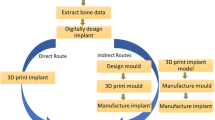Abstract
Purpose
Cranioplasty for recovering skull defects carries the risk for a number of complications. Various materials are used, including autologous bone graft, metallic materials, and non-metallic materials, each of which has advantages and disadvantages. If the use of autologous bone is not feasible, those artificial materials also have constraints in the case of complex anatomy and/or irregular defects.
Material and methods
This study used metal 3D-printing technology to overcome these existing drawbacks and analyze the clinical and mechanical performance requirements. To find an optimal structure that satisfied the structural and mechanical stability requirements, we evaluated biomechanical stability using finite element analysis (FEA) and mechanical testing. To ensure clinical applicability, the model was subjected to histological evaluation. Each specimen was implanted in the femur of a rabbit and was evaluated using histological measurements and push-out test.
Results and Conclusion
We believe that our data will provide the basis for future applications of a variety of unit structures and further clinical trials and research, as well as the direction for the study of other patient-specific implants.









Similar content being viewed by others
References
Thien A, King NK, Ang BT, Wang E, Ng I (2015) Comparison of polyetheretherketone and titanium cranioplasty after decompressive craniectomy. World Neurosurg 83:176–180
Kaufui VW, Aldo Hernandez (2012) A review of additive manufacturing. International Scholarly Research Network, ISRN Mechanical Engineering
Heinl P, Körner C, Singer RF (2008) Selective electron beam melting of cellular titanium: mechanical properties. Adv Eng Mater 10:882–888
Murr LE (2015) Metallurgy of additive manufacturing: examples from electron beam melting. Addit Manuf 5:40–53
Murr LE, Martinez E, Amato KN, Gaytan SM, Hernandez J, Ramirez DA, Shindo PW, Medina F, Wicker RB (2012) Fabrication of metal and alloy components by additive manufacturing: examples of 3D materials science. J Mater Res Technol 1:42–54
Murr LE, Gaytan SM, Medina F, Lopez H, Martinez E, Machado BI, Hernandez DH, Martinez L, Lopez MI, Wicker RB, Bracke J (2010) Next-generation biomedical implants using additive manufacturing of complex, cellular and functional mesh arrays. Philos Trans R Soc A Math Phys Eng Sci 368:1999–2032
Koptyug A, Auml, Nnar (2013) Additive manufacturing technology applications targeting practical surgery. Int J Life Sci Med Res 3:15
Jardini AL, Larosa MA, Maciel Filho R, Zavaglia CA, Bernardes LF, Lambert CS, Calderoni DR, Kharmandayan P (2014) Cranial reconstruction: 3D biomodel and custom-built implant created using additive manufacturing. J Craniomaxillofac Surg 42:1877–1884
Zopf DA, Hollister SJ, Nelson ME, Ohye RG, Green GE (2013) Bioresorbable airway splint created with a three-dimensional printer. N Engl J Med 368:2043–2045
Parthasarathy J, Starly B, Raman S (2011) A design for the additive manufacture of functionally graded porous structures with tailored mechanical properties for biomedical applications. J Manuf Process 13:160–170
Wind JJ, Ohaegbulam C, Iwamoto FM, Black PM, Park JK (2013) Immediate titanium mesh cranioplasty for treatment of postcraniotomy infections. World Neurosurg 79:207.e211–203
Schebesch KM, Hohne J, Gassner HG, Brawanski A (2013) Preformed titanium cranioplasty after resection of skull base meningiomas—a technical note. J Craniomaxillofac Surg 41:803–807
Park EK, Lim JY, Yun IS, Kim JS, Woo SH, Kim DS, Shim KW (2016) Cranioplasty enhanced by three-dimensional printing: custom-made three-dimensional-printed titanium implants for skull defects. J Craniofac Surg 27:943–949
DeFelice S (2014) Additive manufacturing produces polymeric cranial implants. Adv Mater Process 172:36–37
Williams LR, Fan KF, Bentley RP (2015) Custom-made titanium cranioplasty: early and late complications of 151 cranioplasties and review of the literature. Int J Oral Maxillofac Surg 44:599–608
Acknowledgements
This study was supported by a faculty research grant of Yonsei University College of Medicine for 2016 (6-2016-0075). Special thanks to Su-Heon Woo (School of Biomechanical Engineering, Inje University, Gimhae, Korea; Medyssey Co, Ltd. Jecheon, Korea) for his contribution.
Author information
Authors and Affiliations
Corresponding author
Ethics declarations
Disclosure
All authors certify that they have no affiliations with or involvement in any organization or entity with any financial interest or non-financial interest in the subject matter or materials discussed in this manuscript.
Conflict of interest
There is no conflict of interest.
Ethical approval
N/A.
Rights and permissions
About this article
Cite this article
Lim, J.Y., Kim, N., Park, JC. et al. Exploring for the optimal structural design for the 3D-printing technology for cranial reconstruction: a biomechanical and histological study comparison of solid vs. porous structure. Childs Nerv Syst 33, 1553–1562 (2017). https://doi.org/10.1007/s00381-017-3486-y
Received:
Accepted:
Published:
Issue Date:
DOI: https://doi.org/10.1007/s00381-017-3486-y




